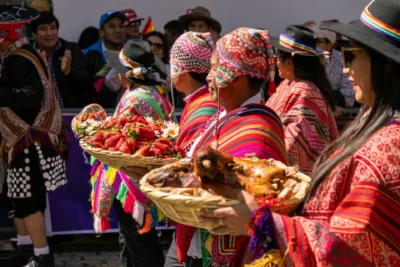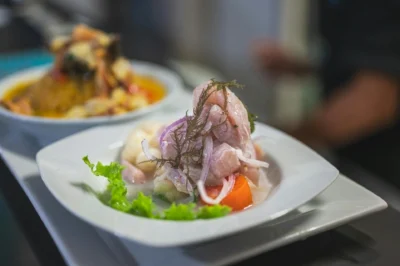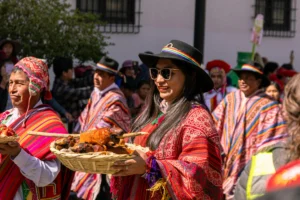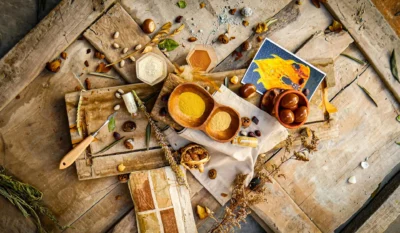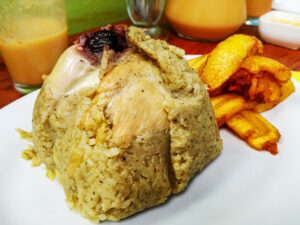En las festividades cusqueñas, especialmente en el Corpus Christi, un plato que destaca tanto por sabor como por su significado cultural es el Chiriuchu. Este platillo representa la diversidad culinaria de Cusco y la mezcla de tradiciones que enriquecen la gastronomía peruana. Con ingredientes de distantes regiones y una preparación especial, el Chiriuchu es más que una comida; es una expresión de la identidad cusqueña y de las raíces andinas.
Si planeas visitar Cusco durante el Curpus Christi, este es un plato que no puedes dejar de probar, Aquí en Machu Picchu Wayna, conocerás el origen, los ingredientes y la importancia cultural del Chiriuchu en esta festividad tan relevante.
Origen y significado del Chiriuchu
El Chiriuchu es un plato tradicional de Cusco, El Chiriuchu tiene su origen en las prácticas comunitarias incaicas, como los Aynis, donde las familias compartían lo mejor de sus alimentos al finalizar las jornadas de trabajo, dando lugar a una combinación de productos de la costa, sierra y selva.
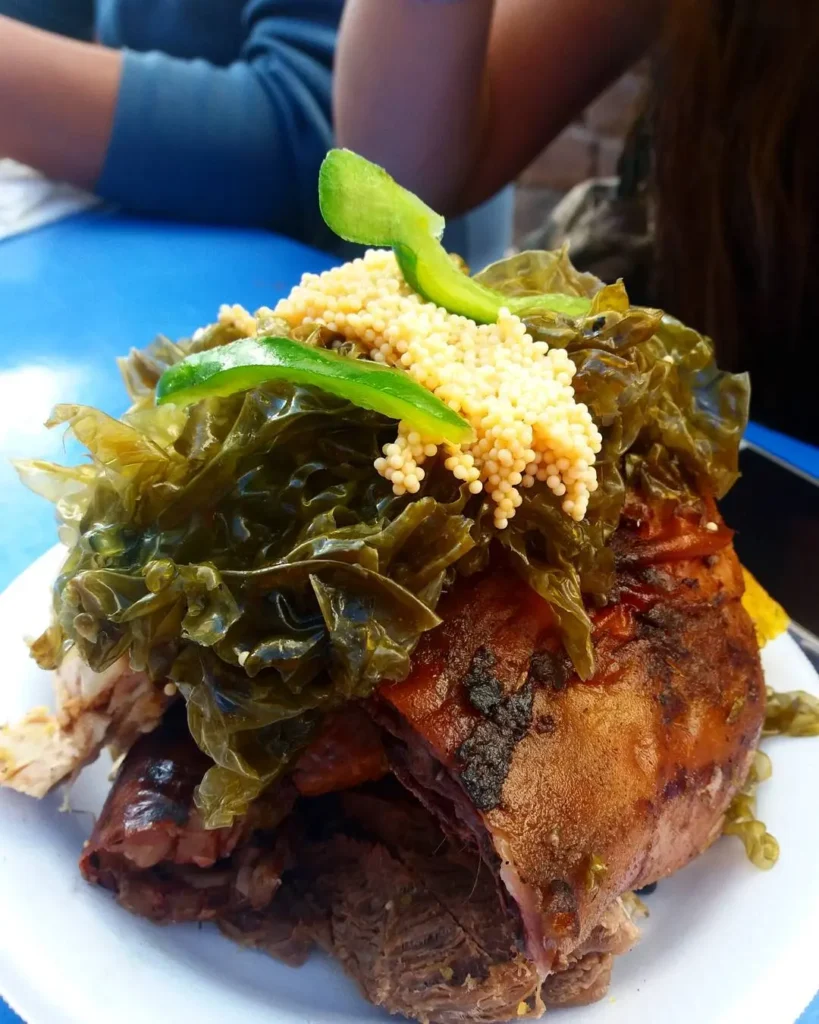
Según el cronista Pedro Sarmiento de Gamboa, este plato refleja la dualidad alimenticia andina, clasificando los alimentos como «machos», provenientes de la tierra, y «chinas», de otros orígenes. Con la llegada de los españoles, las tradiciones andinas se fusionaron con los ritos católicos, incluyendo el Corpus Christi, una festividad que reunió elementos europeos y costumbres indígenas. Este proceso consolidó al Chiriuchu como un símbolo cultural y gastronómico de Cusco, representando la riqueza de su historia y tradiciones.
El nombre Chiriuchu proviene de dos palabras quechuas «chiri», que significa frío, y «uchu», que se traduce como ají o picante. Esto hace referencia a la forma en que se sirve el plato, ya que algunos de sus ingredientes, como el cuy, se sirven fríos, mientras que el ají y otros componentes se añaden para dar sabor y picante.
Ingredientes tradicionales del plato
El Chiriuchu se caracteriza por su abundante variedad de ingredientes, cada uno con un sabor único y una preparación especial. A continuación, te presentamos los componentes tradicionales que conforman este plato:
- Cuy asado: Uno de los alimentos más emblemáticos de la gastronomía andina, símbolo de la cultura y las festividades tradicionales de los pueblos de altura. Se sirve frío, previamente cocido y asado.
- Gallina: Representa la influencia de la cocina europea introducida durante la época colonial. Se utiliza carne sancochada que se corta en pequeñas porciones.
- Chorizos: Producto típico de la región, elaborado a base de carne de cerdo y especias, que aporta un sabor distintivo al plato.
- Huevera de pescado o cau cau: Proveniente de la costa, este ingrediente refleja la conexión entre las regiones costeras y las zonas altas del Perú.
- Queso: Aporta un contraste en textura y sabor, elaborado generalmente con leche de vaca o cabra, tradicional en las zonas altoandinas.
- Torreja de maíz: Preparación a base de harina de maíz, similar a un pequeño panqueque, que agrega una textura diferente al conjunto, y es un símbolo de la agricultura andina.
- Algas (cochayuyo): Recolectadas del mar, aportan un toque salado y son un ejemplo de la integración de productos marinos en la cocina andina.
- Maíz tostado (cancha): Ingrediente andino que simboliza la abundancia de las cosechas. Su textura crujiente complementa los demás componentes.
- Cecina o charqui: Que consiste en carne de res deshidratada y salada, se incorpora al Chiriuchu para aportar un sabor característico y una textura distintiva al conjunto de carnes del plato.
- Rocoto: Un ají característico de la cocina peruana por su intensidad picante, es empleado en el Chiriuchu en forma de tiras, que se utilizan para decorar el plato y añadir un ligero toque de picor.
La disposición de todos estos ingredientes en un plato grande y servidos fríos refleja el valioso patrimonio gastronómico de la región andina del Perú.
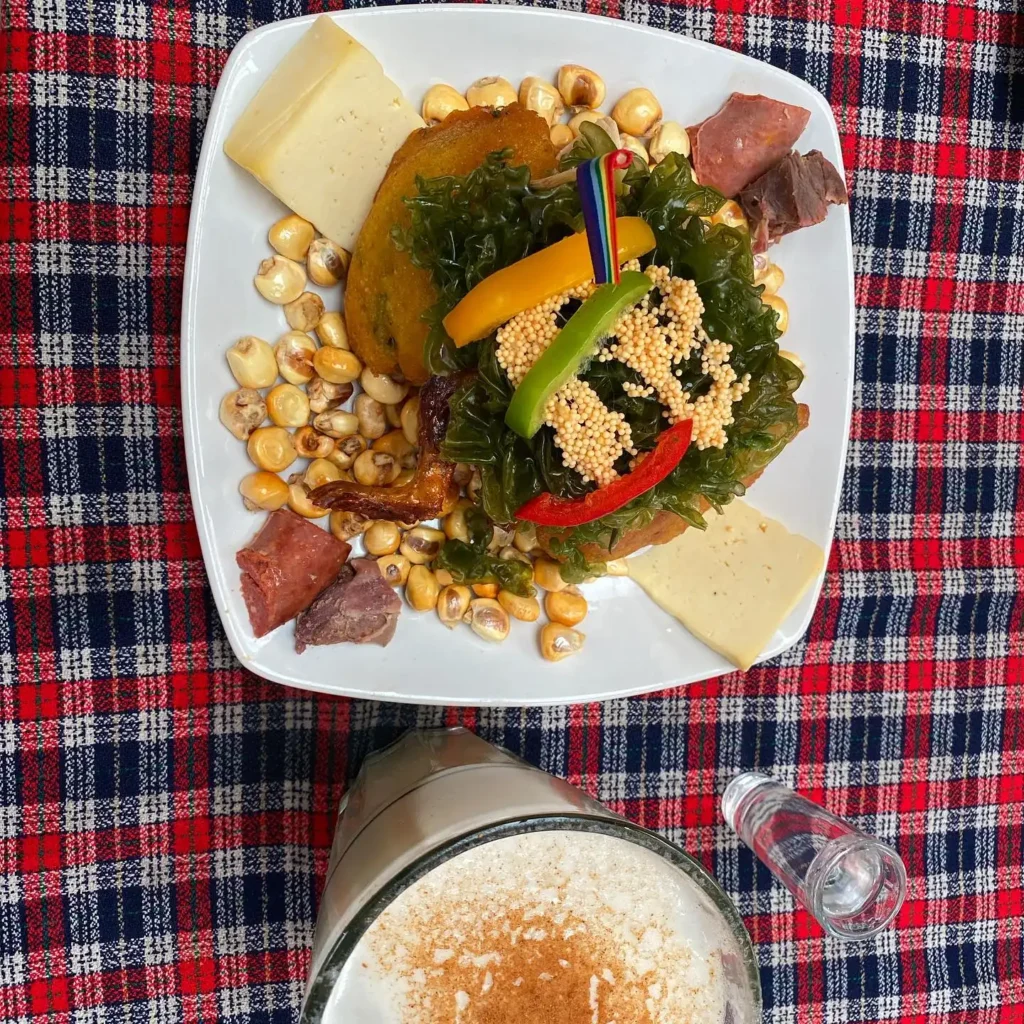
Dónde degustar el Chiriuchu durante el Corpus Christi
Durante el Corpus Christi, el Chiriuchu se puede degustar en varios lugares de Cusco, ya que este plato es tradicionalmente preparado para la festividad. Algunos de los mejores lugares para probarlo incluyen:
- Mercados locales: Los mercados como el Mercado de San Pedro son conocidos por ofrecer comidas típicas de la región, incluyendo el Chiriuchu, especialmente durante las festividades religiosas.
- Plaza San Francisco: Este es un punto donde se suelen montar ferias gastronómicas en época de Corpus Christi, ofreciendo una experiencia auténtica en un entorno cultural.
- Restaurantes tradicionales: Algunos restaurantes de comida tradicional ofrecen Chiriuchu durante la festividad, permitiendo degustarlo en un ambiente más cómodo, aunque la experiencia de probarlo en las ferias locales es más representativa.
- Distritos cercanos: En los distritos como San Sebastián y San Jerónimo, es común que se prepare Chiriuchu durante las celebraciones religiosas, ofreciendo una experiencia más auténtica.
- Plaza de Armas de Cusco: Durante las festividades, algunos puestos de comida en la Plaza de Armas ofrecen Chiriuchu como parte de la oferta gastronómica, lo que permite disfrutarlo en el corazón de la ciudad mientras se vive el ambiente festivo.
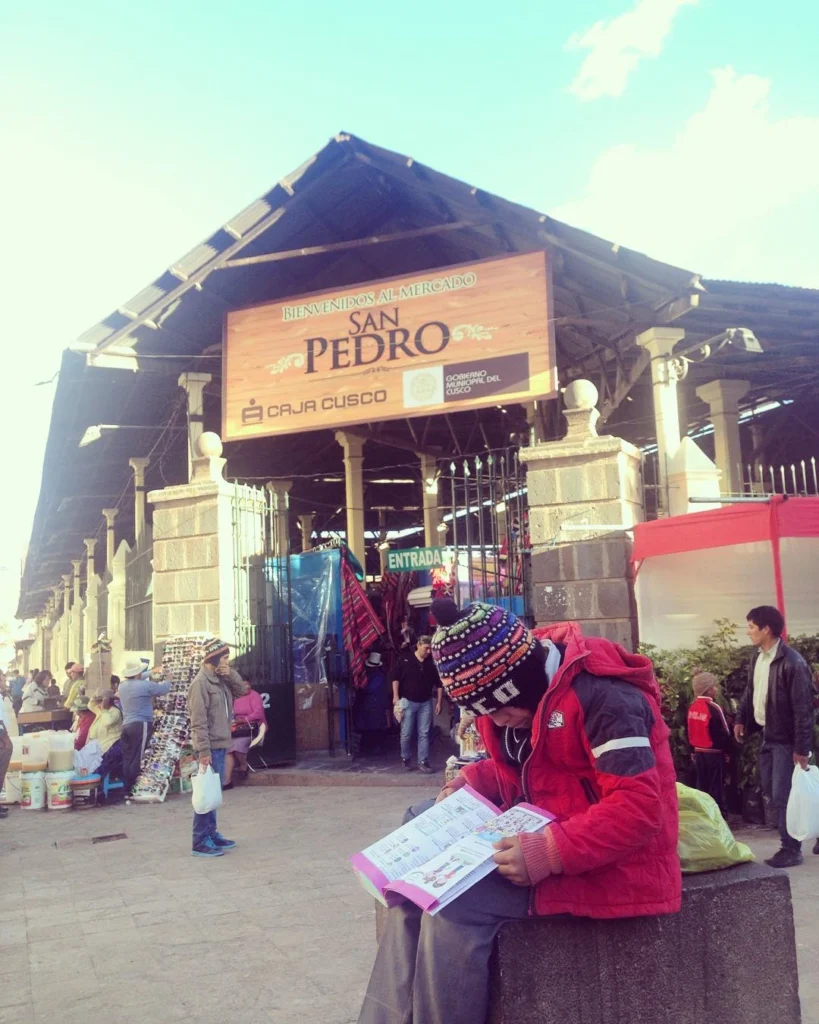
En general, durante el Corpus Christi, el Chiriuchu es una parte importante de la celebración y es posible encontrarlo en numerosos lugares de Cusco, tanto en restaurantes como en eventos y celebraciones comunitarias.
Chiriuchu y otras tradiciones gastronómicas del Corpus Christi
Platos típicos asociados a la festividad
Además del Chiriuchu, el Corpus Christi en Cusco reúne una variedad de platos típicos que reflejan la identidad gastronómica de la región. Entre ellos destacan:
- Lechón al horno: A base de carne de cerdo, este plato es popular durante las festividades y es una opción para quienes buscan un sabor fuerte, sabroso y crujiente.
- Tamales: Hechos a base de maíz y rellenos con carne o vegetales, los tamales son otra opción tradicional.
- Empanadas cusqueñas: Rellenas de carne y especias, las empanadas son una delicia que acompaña a las celebraciones.
Costumbres gastronómicas en las celebraciones
La comida juega un papel esencial en las celebraciones de Corpus Christi, y la degustación del Chiriuchu, junto con otros platos tradicionales, es una forma de rendir homenaje a los ancestros y de fortalecer la conexión con la fe y las tradiciones de Cusco. Durante esta festividad, las familias y comunidades se agrupan para disfrutar de estos manjares, compartiendo un momento de unidad y fraternidad.
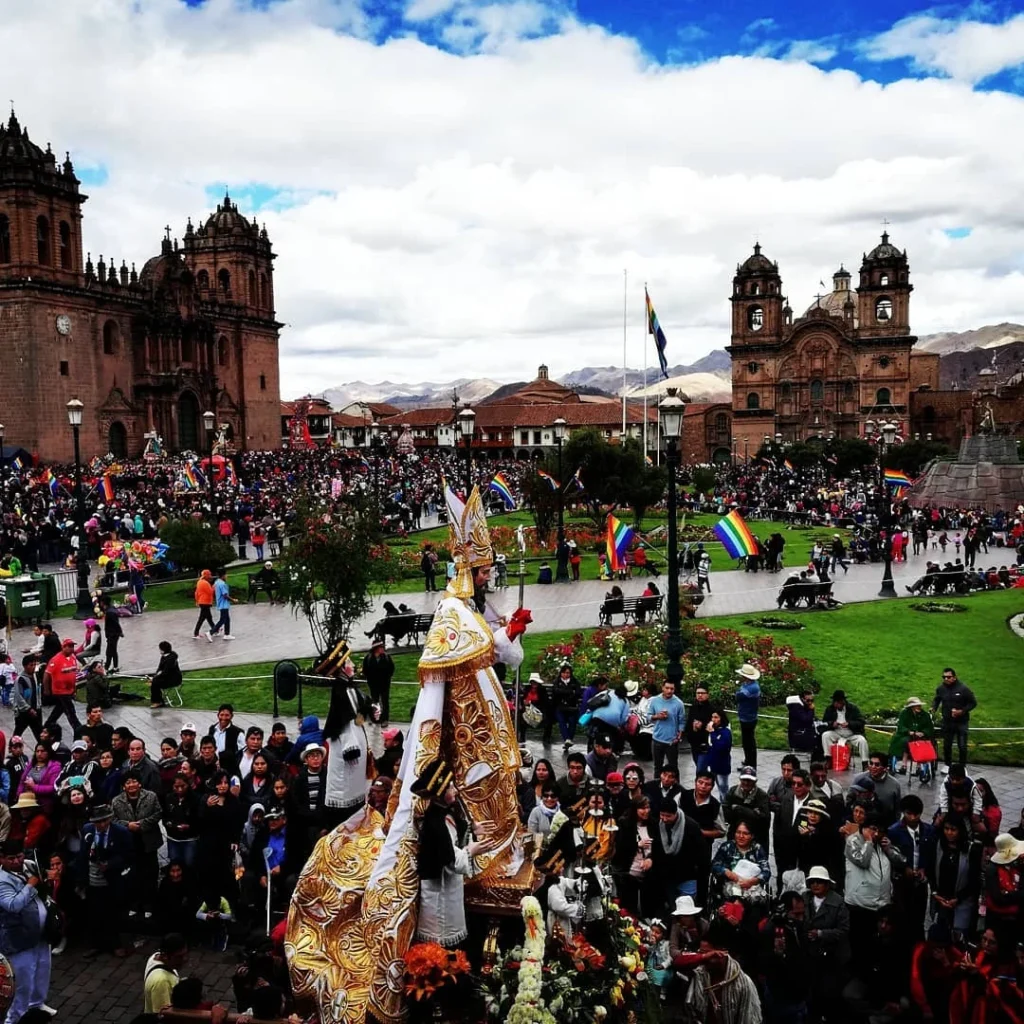
Importancia cultural del Chiriuchu en el Corpus Christi de Cusco
Sincretismo religioso y cultural en la celebración
El sincretismo religioso y cultural en la celebración de Corpus Christi en Cusco surge de la fusión entre las tradiciones católicas y las costumbres indígenas. La festividad, inicialmente cristiana, incorpora rituales andinos como danzas y música, así como la preparación de platos típicos como el Chiriuchu, que combina ingredientes de diversas regiones del país.
Esta mezcla de elementos refleja la adaptación y resistencia de las comunidades cusqueñas ante el colonialismo, creando una celebración única que honra tanto a los santos católicos como a las deidades ancestrales, promoviendo la unión y el respeto por la cultura local.
Impacto del Chiriuchu en la identidad Cusqueña
El Chiriuchu es un plato esencial en la identidad de Cusco, representando la fusión de diversas culturas y tradiciones del Perú. Su consumo durante celebraciones como el Corpus Christi fortalece el vínculo con las tradiciones locales, manteniendo vivas las costumbres ancestrales, mientras muestra cómo estas se han adaptado a influencias coloniales.
Así, el Chiriuchu se ha convertido en un símbolo de resistencia cultural, uniendo a la comunidad cusqueña y promoviendo el orgullo y la unidad en sus festividades, que combinan lo espiritual y lo cultural.
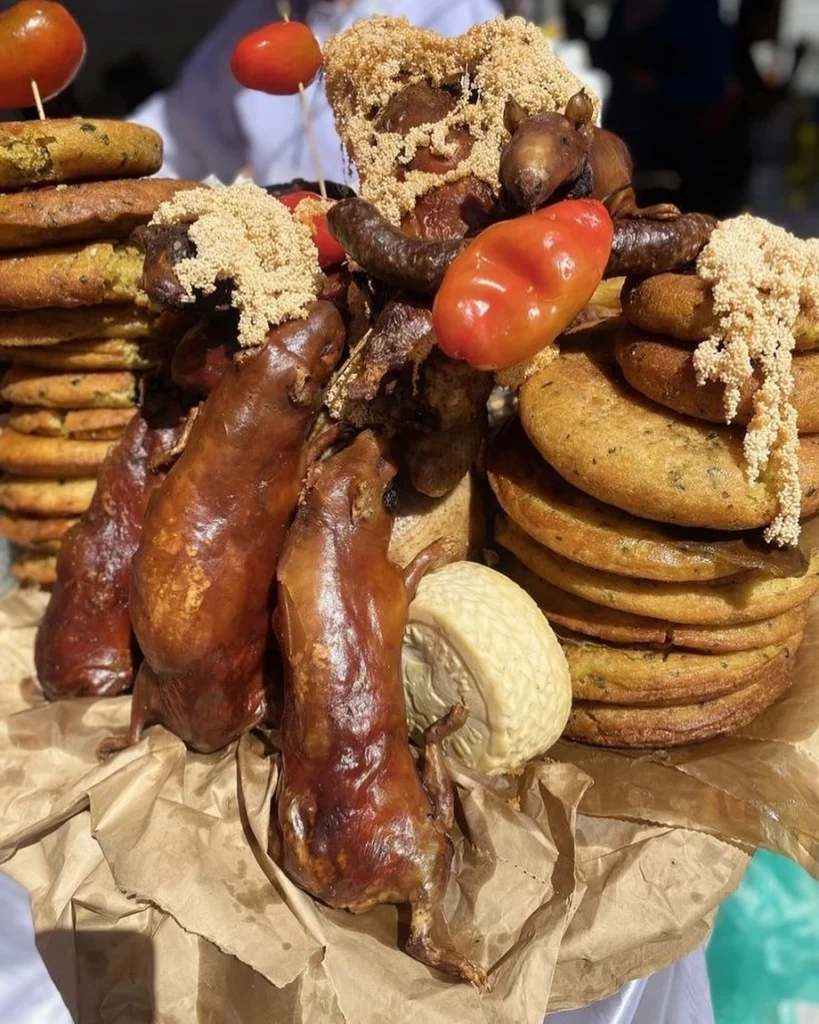
Atractivo turístico de la festividad y la gastronomía
El Corpus Christi y el Chiriuchu son un atractivo para turistas nacionales e internacionales que desean experimentar la cultura cusqueña en su máxima expresión. La gastronomía juega un rol importante en el turismo de Cusco, y degustar el Chiriuchu permite a los visitantes sumergirse en la historia y tradiciones locales.
Consejos para los visitantes durante el Corpus Christi
Fechas y horarios de las celebraciones
Las celebraciones de Corpus Christi en Cusco generalmente comienzan con una ceremonia litúrgica en la Catedral, seguida de una procesión de santos y vírgenes que recorren la Plaza de Armas. Las imágenes de los santos se trasladan desde sus parroquias y participan en este evento, que es acompañando de música, danzas tradicionales y gran fervor religioso.
Durante el día, las imágenes se custodian en la Catedral, donde se quedarán hasta el día siguiente, conocido como «la octava», cuando se realiza otra procesión para regresar a sus parroquias de origen. Este evento se realiza en la última semana de mayo o la primera de junio, dependiendo del calendario litúrgico
Recomendaciones para degustar el Chiriuchu
Si deseas probar el Chiriuchu durante el Corpus Christi, es recomendable lo siguiente:
- Prueba durante la festividad de Corpus Christi: Este es el momento más tradicional para degustar el Chiriuchu, ya que es un platillo típico de la celebración.
- Acompáñalo con bebidas locales: El té de coca o chicha morada son bebidas que combinan muy bien con los sabores del Chiriuchu.
- Busca mercados o puestos locales: La mejor experiencia para disfrutarlo es en los mercados tradicionales o en los puestos callejeros durante la festividad, donde se sirve de manera más auténtica.
- Tómate tu tiempo para disfrutarlo: No es solo una comida, sino también una experiencia cultural que vale la pena saborear tranquilamente en un ambiente comunal.
